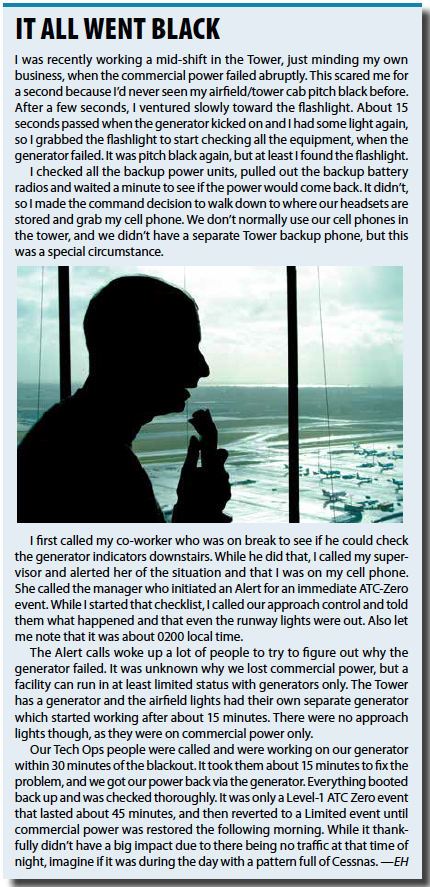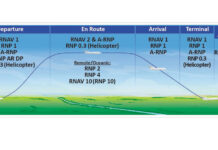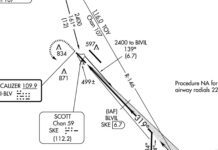While most ATC facilities are open most of the day if not 24 hours, there are times when the physical building must be evacuated or “triggers” occur that require the termination of service. There can be many reasons for this, and the airspace might or might not close depending on facility. It might not be pretty, but it keeps the NAS safe.
What Leads to ATC Zero
When any facility determines it needs to close, notifications are sent out to all neighboring facilities as soon as the decision is made. Depending on the severity of the event, ATC Zero can be enacted in 10 minutes or take as long as a day. All ATC facilities in the NAS are required to have an “Operation Contingency Plan” or OCP. The OCP for a facility is basically instructions and procedures for when that facility has a need to close or limit services based on the trigger. Within an OCP are “Operational Contingency Levels” or OCL—the declared severity of loss. The two main levels of OCL are “ATC Limited” and “ATC Zero.”
Before we talk about “Limited” and “Zero,” we’ll discuss some of the reasons or “triggers” that could cause a facility to lose some or all services. One of the main triggers that can cause a facility to be limited or have to close is loss of communications. We’re controllers, our main job is based on the ability to communicate with pilots, and “keep ’em separated.” When we can’t do that, what good are we?
Some other triggers include power, staffing, evacuation, unresponsive, etc. We need power, staffing, and a facility, that will allow us to do our jobs. If we lose one or more of these at a time, the trigger will occur and it and managers or facility-level administrators determine/declare the limited or zero status via an “ATC Alert.”
An Alert is the first call that something could happen where services might be limited or completely shut down. In some ATC facilities, this could initiate calls for additional controllers at non-affected facilities to help offset the load. An example would be if a TRACON closes, the overlying ARTCC could call upon extra controllers to be in place during the time of the limited or zero event.
These extra controllers would assist in working the airspace that normally is owned by the TRACON as well as help prevent another trigger at their own facility. It’s extremely rare, but still a possibility. An ATC Alert is normally declared only by the impacted facility and should be declared whenever a facility is within a single point of failure. After an Alert is issued, unless the situation is immediately remedied, it will lead to “ATC-Limited” or “ATC-Zero.”
A Limited event is when an ATC facility is unable to provide full service to a portion of the airspace it covers, yet there are other areas covered by that facility that are still in operation. The biggest example of this would be in a TRACON or ARTCC if one “side” or “section” of the facility has equipment problems, the other side can still work. In the Tower, a Staffing trigger could initiate a Limited event which might translate to “no pattern work” or some similar restriction to reduce workload.
This happened during the COVID pandemic and there was only one person working in the tower at a time. Easily remembered, Limited means a facility is still open for business, but may not be as efficient or provide “additional” services such as pattern work or flight following requests. Even at 100 percent on a busy day, some additional services are declined due to volume. In facilities that have a TRACON downstairs and Tower upstairs (also known as an up/down), Limited could mean the Tower was evacuated but the TRACON is still working. Austin, Texas is an example of a “up/down” facility.
If an alert is issued for ATC-Zero, a surprising number of people are directly contacted. The FAA places the highest priority on keeping its facilities open, and mitigating potential events so there is minimal impact to the NAS. ATC-Zero is an operational contingency level that’s declared when a facility is unable to safely provide ATC services. This does not necessarily mean the building will be evacuated, unless it’s a safety hazard for the controllers.
Past that, within ATC-Zero, there are four general response levels. Level-1 is when repair/recovery is imminent and has been verified to be less than a day. Level 2 is when recovery time is uncertain. (Most Alerts start at level 2). Level 3 is when it will be several days but less than a month, and Level 4 is when it’s going to take longer than a month to recover. Levels 1 and 2 are the most common—even during COVID when facilities had to complete “cleanings.”
Depending on the Zero event, controllers could be sent home on administrative leave or sent elsewhere for other purposes. One of those people called when a Zero event is initiated is the main airport operations manager. They will then issue a NOTAM that will go out as quickly as possible. Any airplanes en route to that airport will receive notification in the air or via their company. Pilots then need to figure out a plan of action that suits their mission.

When It’s All Quiet…
If you ever fly through an area that is experiencing an ATC-zero event, there are a few things you can do to help yourself and to help ATC. At best, it’s a challenge when potentially thousands of square miles of airspace close out of nowhere, but we do have procedures to minimize the effect to airplanes in the air. Within the OCP mentioned above, all facilities have documented exactly what happens during a Zero event. Most of the time, the airspace above takes over, or in the case of an ARTCC, the airspace might just close.
In December of 2020, Memphis ARTCC went ATC-Zero for a COVID cleaning. The picture depicted shows how the airspace looked when it started, halfway, then ATC zero. There was no other facility to “take over” and the facility was completely evacuated.
If you are flying along and get notification that an area to which you are traveling or your destination is experiencing an ATC-Zero event, the best thing a pilot can do is to promptly comply with whatever instruction or request ATC gives you. Depending on travel time through the airspace, the extent of the Alert might not even affect you, but let’s assume catastrophic failure.
If it’s just an airport closing, you will need to divert to another airport. If it’s an ARTCC closing its airspace similar to Memphis above, your only option is to exit the airspace as quickly as possible, whether that means to maintain your course, turn around, or divert. TRACON’s have a smaller affect, but most of the time are taken over by the ARTCC above for limited interruptions. This is one of those cases where the ARTCC could be vectoring you to a Class D they don’t normally control, but won’t be entertaining too many VFR flight following requests.
If you are on the ground and become aware of a Zero or Limited event, your options are pretty simple. Wait it out or re-file. Even then, if it’s a facility such as ATL, DFW, IAH (Bravo airports), you will most likely be under a Ground Stop or receive an EDCT time. Not a big deal to re-file to a feeder airport close by.
 When It Opens
When It Opens
When a Zero or Limited event is over, NOTAMs are cancelled and the same notification list that started it is again contacted, but with the updated status. Assuming an airport had a lot of arrivals and a Zero event hit, that event might be lifted or reduced to a Limited event due to volume and/or how fast the facility can reach full operational status. When all is relatively back to normal (within a facility capability), the Limited status will be lifted and business will be back to normal.
On the ATC side of things, we do our best to make sure pilots’ needs are met. At the end of the day, these events aren’t too big a deal, typically just resulting in some diverts and maybe a little extra time. While these events have the potential to happen at any moment, they don’t happen often. There’s no way to anticipate unless you know something before you go. So, if an event does impact you, just help us out so we can keep everyone safe. Worst case is that you could get to visit somewhere you’ve never been.
Like most of us, Elim Hawkins loves to get an unexpected a day off, but not under ATC-Zero circumstances.





